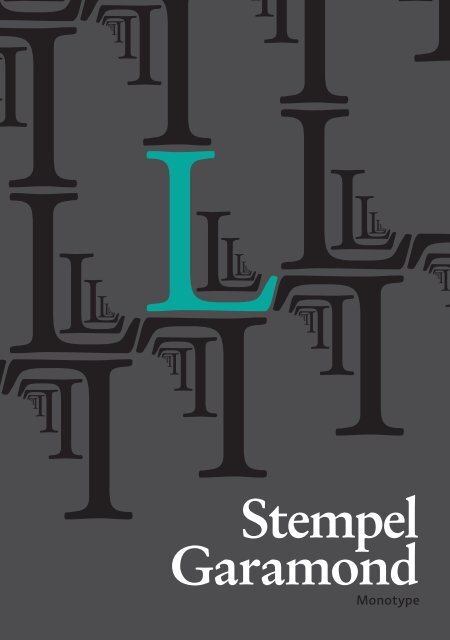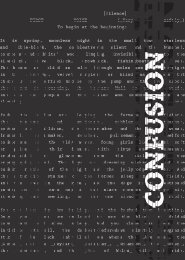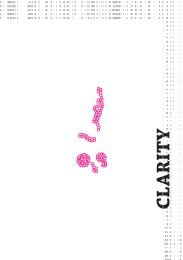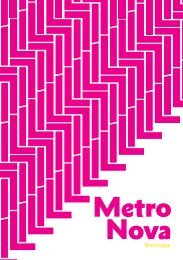stempel garamond
You also want an ePaper? Increase the reach of your titles
YUMPU automatically turns print PDFs into web optimized ePapers that Google loves.
Stempel<br />
Garamond
A typographic explanation<br />
of the fundamental processes<br />
that govern our world.
04 — Contents<br />
06 — Chaos Theory<br />
08 — Aa<br />
10 — Bb<br />
12 — Cc<br />
14 — Dd<br />
16 — Ee<br />
18 — Ff<br />
20 — Gg<br />
22 — Hh<br />
24 — Ii<br />
26 — Jj<br />
28 — Kk<br />
30 — Ll<br />
32 — Mm<br />
34 — Nn<br />
36 — Mandelbrot<br />
38 — Oo<br />
40 — Pp<br />
42 — Qq<br />
44 — Rr<br />
46 — Ss<br />
48 — Tt<br />
50 — Uu<br />
52 — Vv<br />
54 — Ww<br />
56 — Xx<br />
58 — Yy<br />
60 — Zz<br />
62 — Garamond<br />
64 — Stempel Garamond
noun<br />
noun: chaos theory<br />
The branch of mathematics that deals with complex systems whose behavior is<br />
highly sensitive to slight changes in conditions, so that small alterations can give<br />
rise to strikingly great consequences.
The images in this book have been inspired by<br />
the story of ‘Chaos Theory’ and how it has come<br />
to explain some of the most basic questions that<br />
mankind has been asking for thousands of years.<br />
Many of the images are developed from what are<br />
called ‘Mandelbrot Sets’; a stage on the path to our<br />
understanding that produces some truly fascinating<br />
images. The wider story however is set out as an<br />
accompaniment to the images.
For hundreds of years figures of religion,<br />
philosophers and academics have<br />
attempted to answer the fundamental<br />
question: How did we get here? But in<br />
recent years science has overtaken religion<br />
and philosophy in daring to answer this<br />
most fundamental of questions.<br />
The story involves a series of mysterious<br />
and interconnected discoveries that start to<br />
explain how life on our planet has evolved<br />
from the basic particles of inanimate matter<br />
that science has helped us to understand.<br />
Woven into nature’s simplest and most<br />
basic laws is a power to be unpredictable<br />
and yet, almost simultaneously, inanimate<br />
matter can spontaneously create order and<br />
exquisite beauty. The same laws that make<br />
the universe chaotic, spontaneous and<br />
unpredictable can turn simple dust into<br />
human beings.
The natural world is just one great mess of<br />
buzzing confusion. It is a mess of quirky<br />
shapes and blotches. What patterns we see, are<br />
never quite regular and never repeat exactly.<br />
The fact that scientists now think that all this<br />
irregularity is determined by mathematical<br />
rules is at odds with our previous knowledge,<br />
scientific laws and understanding.<br />
Until the early 1900’s Newtonian rules of<br />
understanding explained the workings of the<br />
universe as a giant clockwork type mechanism<br />
based on predictable mathematical rules that<br />
can’t change. But Alan Turing, famous for his<br />
code breaking exploits during the 2nd World<br />
War, was the first person to question whether<br />
the laws of nature could also be understood<br />
using mathematics.<br />
Turing was interested in the idea that<br />
mathematics could be used to describe<br />
biological systems and ultimately intelligence.<br />
This fascination gave rise to the modern<br />
computer, and later in Turing’s life, an even<br />
more radical notion that simple mathematics<br />
could be used to describe the mysterious<br />
processes that take place in an embryo, called<br />
‘Morphogenesis’.<br />
The cells start out identical, but then start<br />
to clump together and change. How do<br />
cells know what part of a being to become,<br />
an eye or an ear or what? This was an<br />
example of something spectacular called<br />
‘self organization’.<br />
Turing published his paper in 1952<br />
explaining through mathematics how<br />
morphogenesis worked. Turing’s equations<br />
described for the first time how biological<br />
systems could self organise. An example of<br />
self organisation is how a sand dune which<br />
is made up of billions of identical sand<br />
particles that have no knowledge of what<br />
shape they are formed into can organise into<br />
ripples and waves and dunes as a result of<br />
the wind. In the same way, chemicals seeping<br />
across an embryo can make identical cells<br />
self organise into different organs. The same<br />
processes explain the markings on animal<br />
skins such as cows and leopards and zebra.
Turing’s work was tragically curtailed<br />
when he was convicted of gross indecency<br />
following an affair with a younger man,<br />
and as a sentence had to undertake a course<br />
of unproven female hormone drugs.<br />
This sent him into a spiral of depression<br />
and he committed suicide soon after. This<br />
is regarded as one of the most shameful<br />
episodes in the history of British science<br />
and the resulting loss to science remains<br />
incalculable. Turing was only 41 years of<br />
age when he died.<br />
Before Turing scientists saw the universe as a<br />
giant complicated machine. The idea was that<br />
the universe is a huge intricate machine that<br />
obeys orderly mathematical rules.<br />
If you knew the rules then the machine<br />
should behave in an entirely predictable way.<br />
Find the rules and then you can predict<br />
everything – this was Newtonian physics.<br />
Irregular behavior was explained by outside<br />
forces. Self organisation seemed absurd.<br />
In the second half of the 20th century,<br />
starting with Turing’s work, the Newtonian<br />
dream was shattered and the scientific<br />
community was literally plunged into chaos.
Another scientist, Edward Lorenz began<br />
working on weather systems using<br />
mathematical systems that could predict<br />
the weather. He started by using traditional<br />
thinking in a Newtonian manner, but<br />
he found he could make no reliable<br />
predictions. Lorenz hit upon the idea that<br />
very small changes in the starting position<br />
of a prediction could result in very major<br />
differences further down the road.<br />
He captured his ideas in a now famous<br />
lecture called, ‘Does the flap of a butterfly’s<br />
wings in Brazil set off a tornado in Texas?’<br />
This led to a new phrase in our language,<br />
‘The Butterfly Effect’.<br />
The discovery of chaos was a real turning<br />
point in the history of science and the tearing<br />
down of the Newtonian dream. Scientists<br />
started to look carefully at Turing and others<br />
work, and the sense that there could be links<br />
between the chaotic nature of the butterfly<br />
effect and natures strange power to self<br />
organize began to grow.
Benoit Mandelbrot was a largely self<br />
taught mathematician and a maverick,<br />
but had a talent for seeing patterns and<br />
form in things where others saw just<br />
chaos. Mandelbrot’s belief was that there<br />
was some unique equation that described<br />
all the shapes in nature. He believed<br />
that underlying nearly all the shapes in<br />
the natural world lies the mathematical<br />
principle of self similarity. The same<br />
shape is repeated over and over again<br />
at smaller and smaller scales. The idea<br />
applies to trees and leaves and blood<br />
vessels in our bodies. Mandelbrot realised<br />
that self similarity was the basis of a new<br />
geometry and gave this a name, ‘Fractals.’
Mandelbrot took up a job at IBM in the<br />
late 1950’s to use the latest in computing<br />
power to continue to study nature.<br />
He drew the Mandelbrot set, which has<br />
been called the thumb print of God.<br />
Baby Mandelbrot’s feeding on themselves<br />
going on for ever all coming from one<br />
very simple, equation z = z 2 + c.<br />
Complex systems thus can be based<br />
on simple rules. A flock of starlings is<br />
a classic example, each bird follows a<br />
simple set of rules but the whole mass<br />
moves unpredictably and without any<br />
bird taking the lead.
Evolution has capitalised on natures self<br />
organising patterns and built on these<br />
by moulding and shaping these complex<br />
systems to match our environment.<br />
Evolution is based on simple rules<br />
and feedback. The simple rule is that<br />
the organism replicates with a few<br />
random mutations every now and then<br />
with feedback that comes from the<br />
environment which favors the mutations<br />
that are most suited to it.<br />
Modern computers have been used to<br />
mimic evolution to demonstrate that<br />
using simple rules, evolution can modify<br />
software automatically and unconsciously<br />
to produce computer simulations much<br />
more superior than man could have<br />
designed or programmed.
Our journey through the work of Turing,<br />
Lorenz and Mandelbrot has shown how<br />
far science has come in explaining what has<br />
historically been the territory of philosophy<br />
and religion. The end result is the evidence<br />
that our ever evolving complexity is<br />
produced without thought or design.
There is a common misconception which<br />
still abides today regarding Garamond<br />
typefaces: that all Garamond types were<br />
based on the typefaces cut by Claude<br />
Garamond in the sixteenth century.<br />
In fact, the Garamond label is quite often<br />
a misnomer, as many of the Garamond<br />
fonts in existence today were in fact<br />
modeled after a later contributor to the<br />
world of type: Jean Jannon.<br />
Jannon, an engraver by trade, was born in<br />
1580 in Switzerland – exactly one century<br />
after Garamond and nineteen years after the<br />
famous publisher’s death. His typographic<br />
life began after he decided to create his own<br />
type to avoid having to have an alphabet<br />
shipped from Paris or Germany which at<br />
that time was quite difficult. His existing<br />
type was also wearing out; a brand new<br />
typeface was finished around 1615, based on<br />
the Garamond of the previous century.<br />
Thus, the confusion around Garamond<br />
and Jannon began. Misidentification of the<br />
Jannon type as Garamond’s work, while<br />
flattering, was later proven inaccurate.<br />
Therefore the many Garamond variations<br />
in existence today are often based on<br />
Jannon or are a typographical hybrid of<br />
the Jannon/Garamond types.<br />
The many users of Garamond include the<br />
Nvidia corporation, who employ the font<br />
for their PDF science publications.<br />
The 1985 Nintendo games console used an<br />
italic variant of the font after the NES text<br />
to describe the individual console types.<br />
DTP Types – a British foundry – have<br />
produced an Infant version of Garamond,<br />
though it is hard to find. The Dr Seuss<br />
books are set in Garamond, as are all of the<br />
American versions of J.K. Rowling’s Harry<br />
Potter series. In fact, the Garamond type is<br />
an extremely popular font for print and has<br />
been since its original conception almost<br />
five hundred years ago.<br />
In 1984, the growing Apple computer<br />
company prepared to launch a range<br />
of computers known as the Macintosh.<br />
They would require marketing material<br />
production and after a number of attempts<br />
at manipulating the existing Garamond<br />
font, Apple commissioned ITC and<br />
Bitstream to create a condensed version for<br />
corporate use. The result was a font which<br />
kept the attractive characteristics of the<br />
original Garamond, while delivering the<br />
versatility necessary. The font delivered to<br />
Apple was named Apple Garamond.<br />
[credit: www.fonts.com/font/linotype/<strong>stempel</strong>-<strong>garamond</strong>]<br />
However, the Stempel Garamond font was<br />
based on a 1592 Garamond specimen by<br />
printer Egenolff-Berner, so the inspiration for<br />
it was indeed the original engraver and not<br />
Jannon. The Monotype Garamond font<br />
family, released three years earlier (1922) is an<br />
example of a Jannon-based typeface.
Roman<br />
A B C D E F G H I J K L M<br />
N O P Q R S T U V W X Y Z<br />
a b c d e f g h i j k l m n o p q r s t u v w x y z<br />
1 2 3 4 5 6 7 8 9 0 , . ? ! ( ) ; : & “<br />
Italic<br />
A B C D E F G H I J K L M<br />
N O P Q R S T U V W X Y Z<br />
a b c d e f g h i j k l m n o p q r s t u v w x y z<br />
1 2 3 4 5 6 7 8 9 0 , . ? ! ( ) ; : & “
Bold<br />
A B C D E F G H I J K L M<br />
N O P Q R S T U V W X Y Z<br />
a b c d e f g h i j k l m n o p q r s t u v w x y z<br />
1 2 3 4 5 6 7 8 9 0 , . ? ! ( ) ; : & “<br />
Bold Italic<br />
A B C D E F G H I J K L M<br />
N O P Q R S T U V W X Y Z<br />
a b c d e f g h i j k l m n o p q r s t u v w x y z<br />
1 2 3 4 5 6 7 8 9 0 , . ? ! ( ) ; : & “
Design does not need an active interfering
designer…<br />
it’s an inherent part of the universe.








